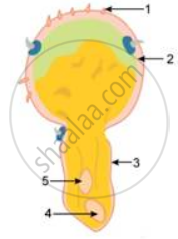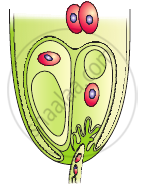Advertisements
Advertisements
प्रश्न
Describe the process of double fertilization in angiosperms and add a note on its significance.
उत्तर
i. Process of double fertilization:
- The fusion of one male gamete with an egg and that of another male gamete with the secondary nucleus is called double fertilization. It is the characteristic feature of angiosperms. It was discovered by Nawaschin in liliaceous plants like Lilium and Fritillaria.
- When pollen grain reaches the surface of the stigma, it germinates and forms a pollen tube.
- Pollen tube penetrates the stigma, style, ovary chamber and then enters the ovule.
- The growth of the pollen tube is guided by the chemicals secreted by the synergids.
- Usually, when a pollen tube enters the ovule through the micropyle, it is termed porogamy. But in some cases, it enters through chalaza which is known as chalazogamy. In some plants, it enters by piercing the integuments which are called mesogamy.
- A pollen tube penetrates the embryo sac of the ovule through its micropylar end.
- The pollen tube carrying male gametes penetrates in one of the synergids.
- Watery contents of synergid are absorbed by pollen tube, due to which it ruptures and releases the contents, including the two non-motile male gametes.
- As non-motile male gametes are carried through hollow pollen tubes, it is known as siphonogamy that ensures fertilization takes place.
- Fertilization mainly involves two processes: Syngamy and Triple fusion.
1. Syngamy: It is the fusion of the haploid male gamete with the haploid female gamete (egg). It results in the formation of a diploid zygote which develops to form an embryo. Syngamy is a type of generative fertilization.
2. Triple fusion:
It is the fusion of the second haploid male gamete with a diploid secondary nucleus. It results in the formation of Primary Endosperm Nucleus (PEN) which develops into triploid endosperm. Triple fusion is a type of vegetative fertilization.
k. In this process, both the male gametes participate, due to which fertilization occurs twice in the same embryo sac, hence it is described as double fertilization.
ii. Significance of double fertilization:
- It is a unique feature of angiosperms.
- It ensures that the parent plant invests a seed with a food store, only if the egg is fertilized.
- The diploid zygote develops into an embryo which consequently develops into a new plant.
- The triploid PEN develops into nutritive endosperm tissue.
- It restores the diploid condition by fusion of haploid male gamete with the haploid female gamete (i.e. through syngamy).
- It also helps to avoid polyembryony.
APPEARS IN
संबंधित प्रश्न
During double fertilization second male gamete fuses with ___________.
What is the function of the pollen tube? Explain it with the help of a diagram.
Given ahead is a diagrammatic sketch of the sectional view of a germinating pollen grain. Study the same and then answer the question that follows:

What happens to the part labelled '5' during the process?
What is ‘double fertilization’? Describe it with the help of a neat and well-labeled diagram. Give its importance.
The seed is a fertilized _______.
After fertilization the ovule becomes ______.
Assertion: Sporopollenin preserves pollen in fossil deposits
Reason: Sporopollenin is resistant to physical and biological decomposition
The total number of nuclei involved in double fertilisation in angiospersm are ______.
Which is the triploid tissue in a fertilised ovule? How is the triploid condition achieved?
In the figure given below label the following parts: male gametes, egg cell, polar nuclei, synergid and pollen tube

